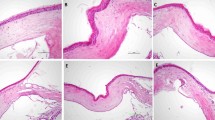Abstract
Aim
This study was to investigate the anti-angiogenic effect of hexahydrocurcumin (HHC) to evaluate gene (p-basic fibroblast growth factor (bFGF)-SAINT-18 & p-vascular endothelial growth factor (VEGF)-SAINT-18 complex)-induced corneal neovascularization (CorNV) in rats.
Methods
CorNV was induced in 24 eyes of 24 rats. Four groups (Group A: 0 μg, B: 0.01 μg, C: 0.1 μg, and D: 1 μg) of HHC were prepared and implanted into the rat subconjunctival substantia propria 1.5 mm from the limbus at temporal side. The 1 μg of p-bFGF-SAINT-18 & p-VEGF-SAINT-18 complex were prepared and implanted into the rat corneal stroma 1.5 mm from the limbus at the same side. Inhibition of CorNV was observed and quantified from day 1 to day 60. bFGF and VEGF protein expression were analyzed by biomicroscopic examination, western blot analysis, and immunohistochemistry.
Results
Subconjunctival injection by 1 μg HHC successfully inhibited gene-induced CorNV in rats. bFGF and VEGF protein expression were reduced after 6 days. Meanwhile, the reduction of HLA-DR expression was detected.
Conclusions
Our study showed that the HHC might provide an important anti-angiogenesis factor to inhibit CorNV development at the corneal experimental angiogenesis model.





Similar content being viewed by others
References
Chang JH, Gabison EE, Kato T, Azar DT (2001) Corneal neovascularization. Curr Opin Ophthalmol 12(4):242–249
Gonzalez L, Loza RJ, Han KY, Sunoqrot S, Cunningham C, Purta P, Drake J, Jain S, Hong S, Chang JH (2013) Nanotechnology in corneal neovascularization therapy—a review. J Ocul Pharmacol Ther 29(2):124–134
Anand P, Thomas SG, Kunnumakkara AB, Sundaram C, Harikumar KB, Sung B, Tharakan ST, Misra K, Priyadarsini IK, Rajasekharan KN, Aggarwal BB (2008) Biological activities of curcumin and its analogues (Congeners) made by man and mother nature. Biochem Pharmacol 76(11):1590–1611
Dempe JS, Scheerle RK, Pfeiffer E, Metzler M (2013) Metabolism and permeability of curcumin in cultured Caco-2 cells. Mol Nutr Food Res 57(9):1543–1549
Deters M, Knochenwefel H, Lindhorst D, Koal T, Meyer HH, Hansel W, Resch K, Kaever V (2008) Different curcuminoids inhibit T-lymphocyte proliferation independently of their radical scavenging activities. Pharm Res 25(8):1822–1827
Somparn P, Phisalaphong C, Nakornchai S, Unchern S, Morales NP (2007) Comparative antioxidant activities of curcumin and its demethoxy and hydrogenated derivatives. Biol Pharm Bull 30(1):74–78
Srimuangwong K, Tocharus C, Yoysungnoen Chintana P, Suksamrarn A, Tocharus J (2012) Hexahydrocurcumin enhances inhibitory effect of 5-fluorouracil on HT-29 human colon cancer cells. World J Gastroenterol 18(19):2383–2389
Moohammadaree A, Changtam C, Wicha P, Suksamrarn A, Tocharus J, Tocharus C (2015) Mechanisms of vasorelaxation induced by hexahydrocurcuminin isolated rat thoracic aorta. Phytother Res 29(11):1806–1813
Kuo CN, Yang LC, Yang CT, Chen MF, Lai CH, Chen YH, Chen CH, Chen CH, Wu PC, Kou HK, Tsai JC, Hung CH (2008) A novel vector system for gene transfer into the cornea using a partially dried plasmid expressing 18 basic fibroblast growth factor-synthetic amphiphile INTeraction-18 (SAINT-18) complex. Curr Eye Res 33(10):839–848
Kuo CN, Yang LC, Yang CT, Lai CH, Chen MF, Chen CY, Chen CH, Wu PC, Kou HK, Chen YJ, Hung CH, Tsai CB (2009) Inhibition of corneal neovascularization with plasmid pigment epithelium-derived factor (p-PEDF) delivered by synthetic amphiphile INTeraction-18 (SAINT-18) vector in an experimental model of rat corneal angiogenesis. Exp Eye Res 89(5):678–685
Lin RJ, Chen CY, Chung LY, Yen CM (2010) Larvicidal activities of ginger (Zingiber officinale) against Angiostrongylus cantonensis. Acta Trop 115(1–2):69–76
Kuo CN, Chen CY, Chen SN, Yang LC, Lai LJ, Lai CH, Chen MF, Hung CH, Chen CH (2013) Inhibition of corneal neovascularization with the combination of bevacizumab and plasmid pigment epithelium-derived factor-synthetic amphiphile INTeraction-18 (p-PEDF-SAINT-18) vector in a rat corneal experimental angiogenesis model. Int J Mol Sci 14(4):8291–8305
Chang JH, Garg NK, Lunde E, Han KY, Jain S, Azar DT (2012) Corneal neovascularization: an anti-VEGF therapy review. Surv Ophthalmol 57(5):415–429
Ding X, Patel M, Chan CC (2009) Molecular pathology of age-related macular degeneration. Prog Retin Eye Res 28(1):1–18
Kubicka-Trzaska A, Karska-Basta I, Romanowska-Dixon B (2014) Current concepts in pathogenesis of age-related macular degeneration. Klin Oczna 116(4):277–282
Rezaei KA, Toma HS, Cai J, Penn JS, Sternberg P, Kim SJ (2011) Reduced choroidal neovascular membrane formation in cyclooxygenase-2 null mice. Investig Ophthalmol Vis Sci 52(2):701–707. doi:10.1167/iovs.10-6319
Kenyon BM, Voest EE, Chen CC, Flynn E, Folkman J, D’Amato RJ (1996) A model of angiogenesis in the mouse cornea. Investig Ophthalmol Vis Sci 37(8):1625–1632
Adamis AP, Meklir B, Joyce NC (1991) In situ injury-induced release of basic-fibroblast growth factor from corneal epithelial cells. Am J Pathol 139(5):961–967
Klein-Soyer C, Beretz A, Cazenave JP, Driot F, Maffrand JP (1990) Behavior of confluent endothelial cells after irradiation. Modulation of wound repair by heparin and acidic fibroblast growth factor. Biol Cell 68(3):231–238
Benelli U, Bocci G, Danesi R, Lepri A, Bernardini N, Bianchi F, Lupetti M, Dolfi A, Campagni A, Agen C, Nardi M, Del Tacca M (1998) The heparan sulfate suleparoide inhibits rat corneal angiogenesis and in vitro neovascularization. Exp Eye Res 67(2):133–142
Amano S, Rohan R, Kuroki M, Tolentino M, Adamis AP (1998) Requirement for vascular endothelial growth factor in wound- and inflammation-related corneal neovascularization. Investig Ophthalmol Vis Sci 39(1):18–22
Kojima T, Azar DT, Chang JH (2008) Neostatin-7 regulates bFGF-induced corneal lymphangiogenesis. FEBS Lett 582(17):2515–2520
Duenas Z, Torner L, Corbacho AM, Ochoa A, Gutierrez-Ospina G, Lopez-Barrera F, Barrios FA, Berger P, Martinez de la Escalera G, Clapp C (1999) Inhibition of rat corneal angiogenesis by 16-kDa prolactin and by endogenous prolactin-like molecules. Investig Ophthalmol Vis Sci 40(11):2498–2505
Ogata N, Wada M, Otsuji T, Jo N, Tombran-Tink J, Matsumura M (2002) Expression of pigment epithelium-derived factor in normal adult rat eye and experimental choroidal neovascularization. Investig Ophthalmol Vis Sci 43(4):1168–1175
Acknowledgements
This work was supported by a project grant from Chang Gung Memorial Hospital Grand (CMRPG6D0141).
Author information
Authors and Affiliations
Corresponding authors
Ethics declarations
Conflict of interest
The authors declare no competing financial interest.
Rights and permissions
About this article
Cite this article
Kuo, CN., Chen, CH., Chen, SN. et al. Anti-angiogenic effect of hexahydrocurcumin in rat corneal neovascularization. Int Ophthalmol 38, 747–756 (2018). https://doi.org/10.1007/s10792-017-0530-6
Received:
Accepted:
Published:
Issue Date:
DOI: https://doi.org/10.1007/s10792-017-0530-6




